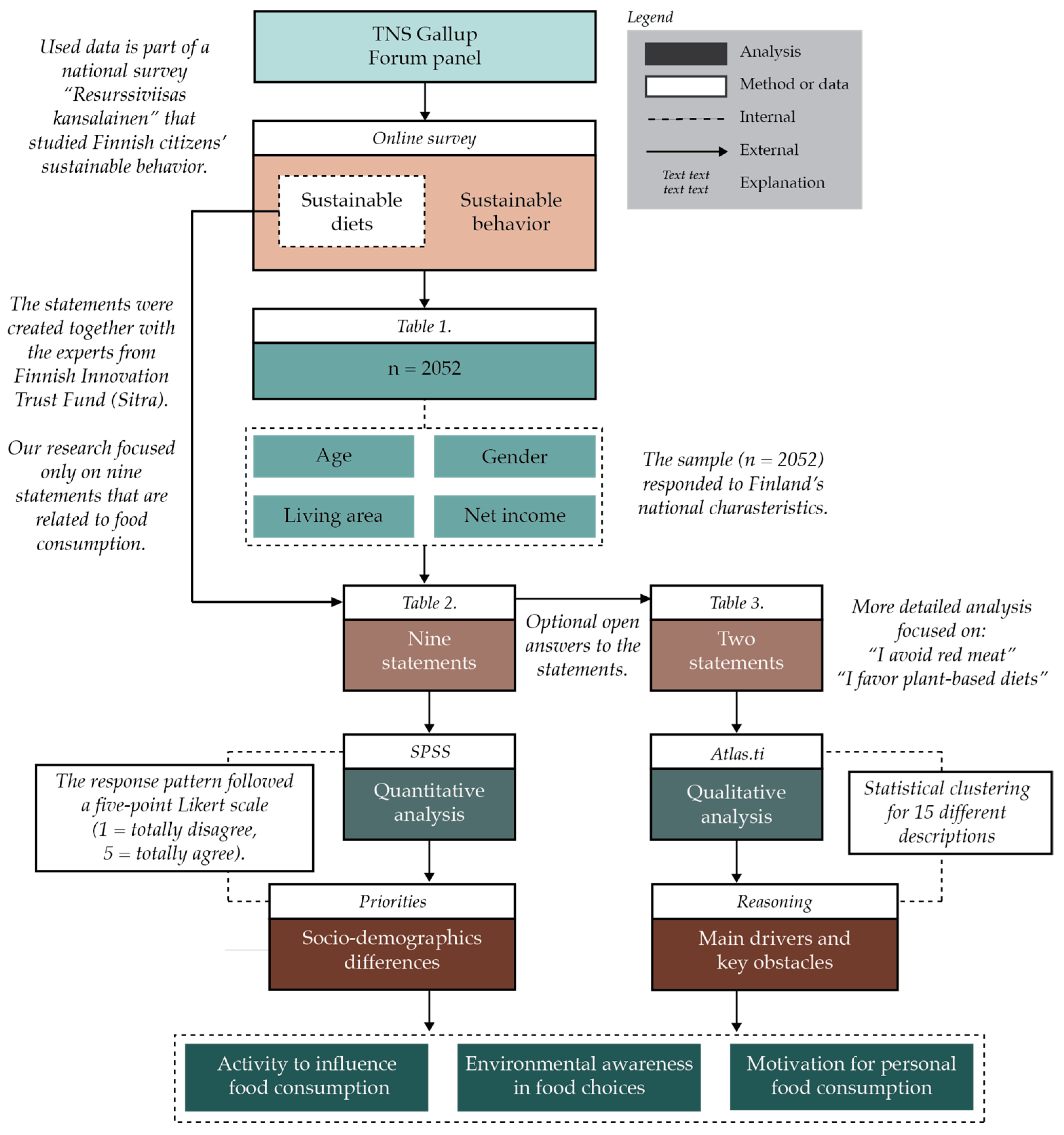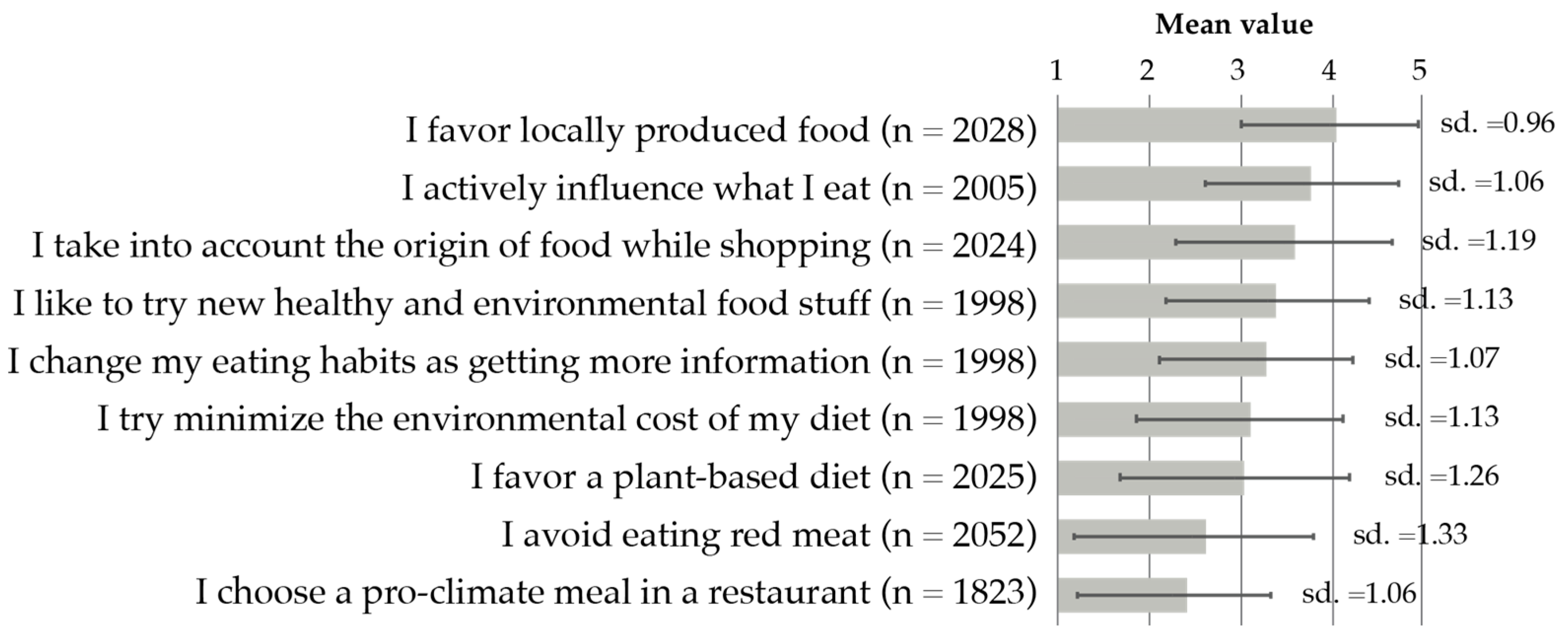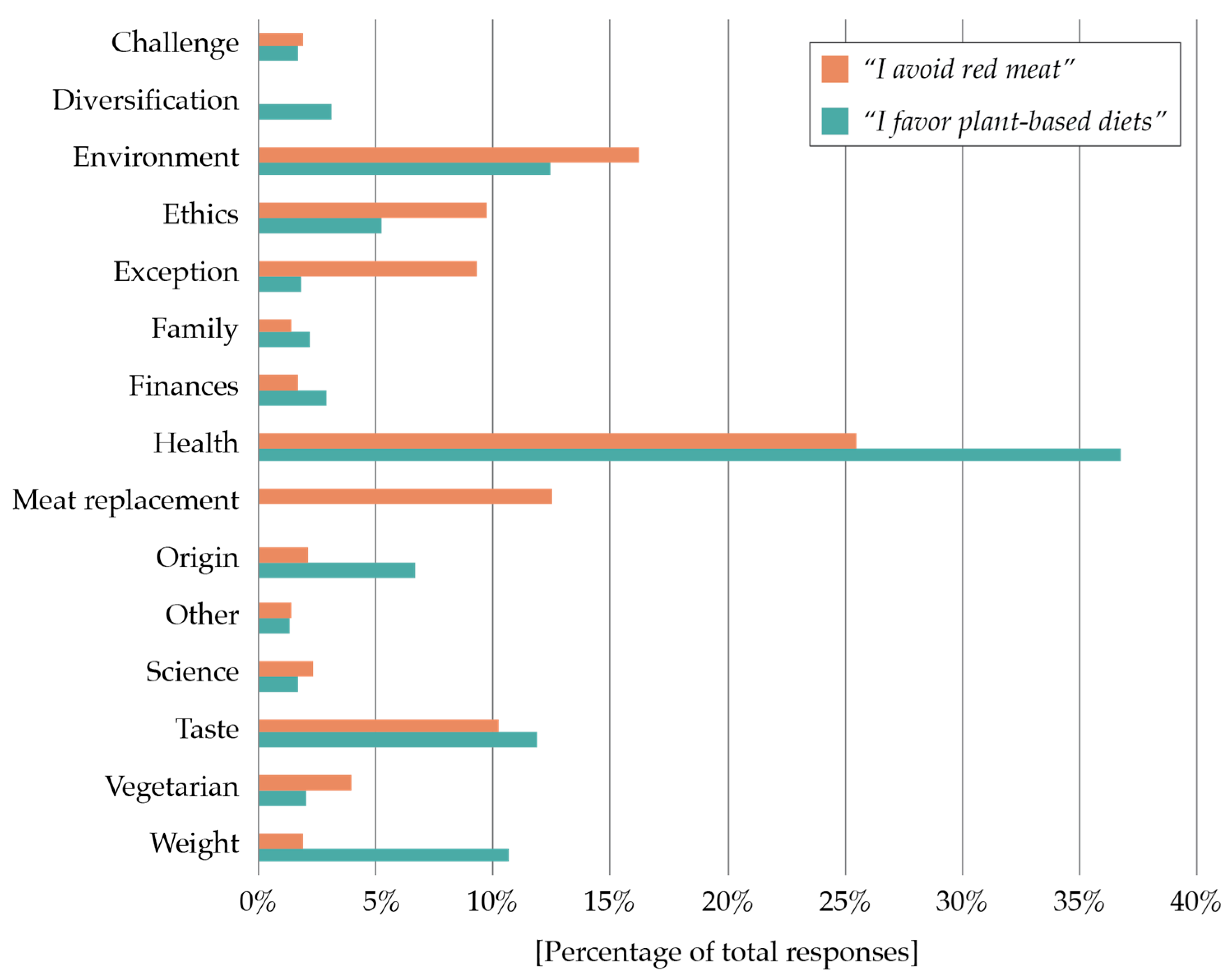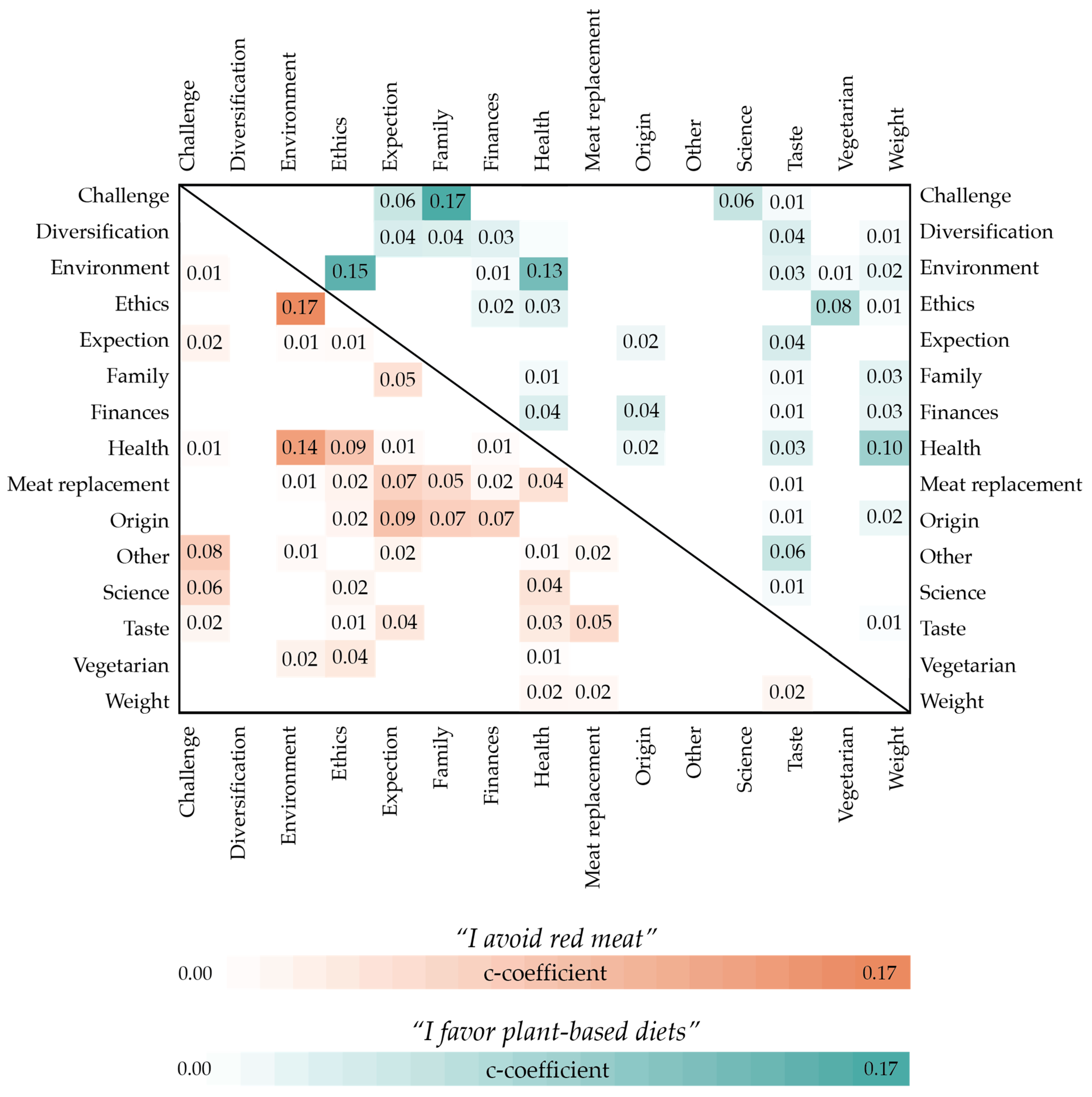Food Preferences in Finland: Sustainable Diets and their Differences between Groups
Abstract
1. Introduction
2. Diet Choices in Everyday Life
2.1. Sustainable Diets Regarding People and the Environment
2.2. Features Behind Choosing Sustainable Diets
2.2.1. Motivation for Personal Food Consumption
2.2.2. Environmental Awareness in Food Choices
2.2.3. Activity to Influence on Food Consumption
2.3. Research Questions for this Study
3. Materials and Methods
4. Results
4.1. Descriptive Statistics
4.2. Differences between Groups
4.3. Reasoning of Food Choices
5. Discussion and Concluding Remarks
5.1. Progressive Urban Women and Wealthy Middle-Aged Men
5.2. The Potential Towards More Sustainable Diets in Finland
5.3. Limitations of the Study and Future Research
6. Conclusions
Author Contributions
Acknowledgments
Conflicts of Interest
References
- Gerland, P.; Raftery, A.E.; Ševčíková, H.; Li, N.; Gu, D.; Spoorenberg, T.; Alkema, L.; Fosdick, B.K.; Chunn, J.; Lalic, N.; et al. World population stabilization unlikely this century. Science 2014, 346, 234–237. [Google Scholar] [CrossRef] [PubMed]
- United Nations. World Population Prospects: The 2017 Revision, Key Findings and Advance Tables; ESA/P/WP/248; United Nations Department of Economic and Social Affairs/Population Division: New York, NY, USA, 2017. [Google Scholar]
- Kummu, M.; Fader, M.; Gerten, D.; Guillaume, J.H.; Jalava, M.; Jägermeyr, J.; Pfister, S.; Porkka, M.; Siebert, S.; Varis, O. Bringing it all together: Linking measures to secure nations’ food supply. Curr. Opin. Environ. Sustain. 2017, 29, 98–117. [Google Scholar] [CrossRef]
- Springmann, M.; Clark, M.; Mason-D’Croz, D.; Wiebe, K.; Bodirsky, B.L.; Lassaletta, L.; de Vries, W.; Vermeulen, S.J.; Herrero, M.; Carlson, K.M.; et al. Options for keeping the food system within environmental limits. Nature 2018, 562, 519–525. [Google Scholar] [CrossRef] [PubMed]
- Mäkelä, J. Syömisen rakenne ja kulttuurinen vaihtelu; Kuluttajatutkimuskeskus: Helsinki, Finland, 2002. [Google Scholar]
- Grunert, K.G. Future trends and consumer lifestyles with regard to meat consumption. Meat Sci. 2006, 74, 149–160. [Google Scholar] [CrossRef] [PubMed]
- Wahlqvist, M.L.; Lee, M.-S. Regional Food Culture and Development. Asia Pac. J. Clin. Nutr. 2007, 16, 2–7. [Google Scholar] [PubMed]
- Fogelholm, M.; Hopia, A.; Katajajuuri, J.-M.; Kulanko, H.; Lehtonen, H.; Luukkonen, O.; Mäkelä, J.; Niva, M.; Ovaskainen, M.-L.; Pohjolainen, P.; et al. Vähemmän lihaa. Kohti kestävää ruokakulttuuria; Mattila, H., Ed.; Gaudeamus: Helsinki, Finland, 2016; ISBN 978-952-495-388-7. [Google Scholar]
- Hartmann, C.; Siegrist, M. Consumer perception and behaviour regarding sustainable protein consumption: A systematic review. Trends Food Sci. Technol. 2017, 61, 11–25. [Google Scholar] [CrossRef]
- Sabaté, J.; Soret, S. Sustainability of plant-based diets: Back to the future. Am. J. Clin. Nutr. 2014, 100, 476S–482S. [Google Scholar] [CrossRef] [PubMed]
- Mithril, C.; Dragsted, L.O.; Meyer, C.; Blauert, E.; Holt, M.K.; Astrup, A. Guidelines for the New Nordic Diet. Public Health Nutr. 2012, 15, 1941–1947. [Google Scholar] [CrossRef] [PubMed]
- Vanhonacker, F.; Van Loo, E.J.; Gellynck, X.; Verbeke, W. Flemish consumer attitudes towards more sustainable food choices. Appetite 2013, 62, 7–16. [Google Scholar] [CrossRef] [PubMed]
- Vermeir, I.; Verbeke, W. Sustainable food consumption among young adults in Belgium: Theory of planned behaviour and the role of confidence and values. Ecol. Econ. 2008, 64, 542–553. [Google Scholar] [CrossRef]
- Jarvela, K.; Makela, J.; Piiroinen, S. Consumers’ everyday food choice strategies in Finland. Int. J. Consum. Stud. 2006, 30, 309–317. [Google Scholar] [CrossRef]
- Salonen, A.O.; Fredriksson, L.; Järvinen, S.; Korteniemi, P.; Danielsson, J. Sustainable Consumption in Finland—The Phenomenon, Consumer Profiles, and Future Scenarios. Int. J. Mark. Stud. 2014, 6, 59–82. [Google Scholar] [CrossRef]
- Cordts, A.; Nitzko, S.; Spiller, A. Consumer Response to Negative Information on Meat Consumption in Germany. Int. Food Agribus. Manag. Rev. 2014, 17, 83–106. [Google Scholar]
- De Boer, J.; Schösler, H.; Aiking, H. “Meatless days” or “less but better”? Exploring strategies to adapt Western meat consumption to health and sustainability challenges. Appetite 2014, 76, 120–128. [Google Scholar] [CrossRef] [PubMed]
- Schösler, H.; de Boer, J.; Boersema, J.J.; Aiking, H. Meat and masculinity among young Chinese, Turkish and Dutch adults in the Netherlands. Appetite 2015, 89, 152–159. [Google Scholar] [CrossRef] [PubMed]
- Macdiarmid, J.I.; Douglas, F.; Campbell, J. Eating like there’s no tomorrow: Public awareness of the environmental impact of food and reluctance to eat less meat as part of a sustainable diet. Appetite 2016, 96, 487–493. [Google Scholar] [CrossRef] [PubMed]
- Campbell-Arvai, V. Food-related environmental beliefs and behaviours among university undergraduates: A mixed-methods study. Int. J. Sustain. High. Educ. 2015, 16, 279–295. [Google Scholar] [CrossRef]
- Åby, B.A.; Kantanen, J.; Aass, L.; Meuwissen, T. Current status of livestock production in the Nordic countries and future challenges with a changing climate and human population growth. Acta Agric. Scand. Sect. A Anim. Sci. 2014, 64, 73–97. [Google Scholar] [CrossRef]
- Gerber, P.J.; Steinfeld, H.; Henderson, B.; Mottet, A.; Opio, C.; Dijkman, J.; Falcucci, A.; Tempio, G. Tackling Climate Change through Livestock: A Global Assessment of Emissions and Mitigation Opportunities; Gerber, P.J., Steinfeld, H., Mottet, A., Opio, C., Dijkman, J., Falcucci, A., Tempio, G., Eds.; Food and Agriculture Organization of the United Nations: Rome, Italy, 2013; ISBN 978-92-5-107920-1. [Google Scholar]
- FAOSTAT Food Balance Sheets. Available online: http://www.fao.org/faostat/en/#data/FBS (accessed on 24 September 2018).
- Vinnari, M.; Tapio, P. Future images of meat consumption in 2030. Futures 2009, 41, 269–278. [Google Scholar] [CrossRef]
- Valsta, L.; Kaartinen, N.; Tapanainen, H.; Männistö, S.; Sääksjärvi, K. Ravitsemus Suomessa—FinRavinto 2017-tutkimus [Nutrition in Finland—The National FinDiet 2017 Survey]; Institute for Health and Welfare (THL): Helsinki, Finland, 2018; p. 239. [Google Scholar]
- Fogelholm, M.; Hakala, P.; Kara, R.; Kiuru, S.; Kurppa, S.; Kuusipalo, H.; Laitinen, J.; Marniemi, A.; Misikangas, M.; Roo, E.; et al. Suomalaiset ravitsemussuositukset; Valtion ravitsemusneuvottelukunta: Tampere, Finland, 2014; p. 60. [Google Scholar]
- Burlingame, B.; Dernini, S. Sustainable Diets and Biodiversity—Directions and Solutions for Policy Research and Action. In Proceedings of the International Scientific Symposium Biodiversity and Sustainable Diets United Against Hunger, Rome, Italy, 3–5 November 2010; Burlingame, B., Dernini, S., Eds.; FAO: Rome, Italy, 2012; ISBN 978-92-5-107288-2. [Google Scholar]
- Nordic Council of Ministers. Nordic Nutrition Recommendations 2012. Integrating Nutrition and Physical Activity, 5th ed.; Nordic Council of Ministers: Copenhagen, Denmark, 2014; p. 629. [Google Scholar]
- Salonen, A.O.; Helne, T.T. Vegetarian Diets: A Way towards a Sustainable Society. J. Sustain. Dev. 2012, 5. [Google Scholar] [CrossRef]
- De Bakker, E.; Dagevos, H. Reducing Meat Consumption in Today’s Consumer Society: Questioning the Citizen-Consumer Gap. J. Agric. Environ. Ethics 2012, 25, 877–894. [Google Scholar] [CrossRef]
- Jalava, M.; Kummu, M.; Porkka, M.; Siebert, S.; Varis, O. Diet change—A solution to reduce water use? Environ. Res. Lett. 2014, 9, 074016. [Google Scholar] [CrossRef]
- Hoek, A.C.; Luning, P.A.; Weijzen, P.; Engels, W.; Kok, F.J.; de Graaf, C. Replacement of meat by meat substitutes. A survey on person- and product-related factors in consumer acceptance. Appetite 2011, 56, 662–673. [Google Scholar] [CrossRef] [PubMed]
- Ruby, M.B.; Heine, S.J. Meat, morals, and masculinity. Appetite 2011, 56, 447–450. [Google Scholar] [CrossRef] [PubMed]
- Schösler, H.; de Boer, J.; Boersema, J.J. Can we cut out the meat of the dish? Constructing consumer-oriented pathways towards meat substitution. Appetite 2012, 58, 39–47. [Google Scholar] [CrossRef] [PubMed]
- Tobler, C.; Visschers, V.H.M.; Siegrist, M. Eating green. Consumers’ willingness to adopt ecological food consumption behaviors. Appetite 2011, 57, 674–682. [Google Scholar] [CrossRef] [PubMed]
- Ruby, M.B. Vegetarianism. A blossoming field of study. Appetite 2012, 58, 141–150. [Google Scholar] [CrossRef] [PubMed]
- Neumann, C.; Harris, D.M.; Rogers, L.M. Contribution of animal source foods in improving diet quality and function in children in the developing world. Nutr. Res. 2002, 22, 193–220. [Google Scholar] [CrossRef]
- McAfee, A.J.; McSorley, E.M.; Cuskelly, G.J.; Moss, B.W.; Wallace, J.M.W.; Bonham, M.P.; Fearon, A.M. Red meat consumption: An overview of the risks and benefits. Meat Sci. 2010, 84, 1–13. [Google Scholar] [CrossRef] [PubMed]
- Pan, A.; Sun, Q.; Bernstein, A.M.; Schulze, M.B.; Manson, J.E.; Stampfer, M.J.; Willett, W.C.; Hu, F.B. Red Meat Consumption and Mortality: Results From 2 Prospective Cohort Studies. Arch. Intern. Med. 2012, 172, 555. [Google Scholar] [PubMed]
- Sinha, R.; Cross, A.J.; Graubard, B.I.; Leitzmann, M.F.; Schatzkin, A. Meat Intake and Mortality: A Prospective Study of Over Half a Million People. Arch. Intern. Med. 2009, 169, 562. [Google Scholar] [CrossRef] [PubMed]
- WHO. Diet, Nutrition, and the Prevention of Chronic Diseases: Report of a WHO-FAO Expert Consultation; WHO technical report series; World Health Organization: Geneva, Switzerland, 2003; ISBN 978-92-4-120916-8. [Google Scholar]
- Bouvard, V.; Loomis, D.; Guyton, K.; Grosse, Y.; El Ghissassi, F.; Benbrahim-Tallaa, L.; Guha, N.; Mattock, H.; Straif, K. Carcinogenicity of consumption of red and processed meat. Lancet Oncol. 2015, 16, 1599–1600. [Google Scholar] [CrossRef]
- Pan, A.; Sun, Q.; Bernstein, A.M.; Schulze, M.B.; Manson, J.E.; Willett, W.C.; Hu, F.B. Red meat consumption and risk of type 2 diabetes: 3 cohorts of US adults and an updated meta-analysis. Am. J. Clin. Nutr. 2011, 94, 1088–1096. [Google Scholar] [CrossRef] [PubMed]
- WHO. A Healthy Diet Sustainably Produced, Information Sheet; World Health Organization: Geneva, Switzerland, 2018; p. 7. [Google Scholar]
- WCRF. Recommendations and Public Health and Policy Implications; Continuous Update Project Expert Report 2018; World Cancer Research Fund/American Institute for Cancer Research: London, UK, 2018; p. 92. [Google Scholar]
- Hoekstra, A.Y. The hidden water resource use behind meat and dairy. Anim. Front. 2012, 2, 3–8. [Google Scholar] [CrossRef]
- Steinfeld, H.; Gerber, P.; Wassenaar, T.D.; Castel, V.; Rosales, M.; de Haan, C. Livestock’s Long Shadow: Environmental Issues and Options; Food and Agriculture Organization of the United Nations: Rome, Italy, 2006; ISBN 978-92-5-105571-7. [Google Scholar]
- Kummu, M.; Varis, O. The world by latitudes: A global analysis of human population, development level and environment across the north–south axis over the past half century. Appl. Geogr. 2011, 31, 495–507. [Google Scholar] [CrossRef]
- Lehikoinen, E.; Parviainen, T.; Helenius, J.; Jalava, M.; Salonen, A.; Kummu, M. Cattle Production for Exports in Water-Abundant Areas: The Case of Finland. Sustainability 2019, 11, 1075. [Google Scholar] [CrossRef]
- Kearney, J. Food consumption trends and drivers. Philos. Trans. R. Soc. B Biol. Sci. 2010, 365, 2793–2807. [Google Scholar] [CrossRef] [PubMed]
- Smil, V. Worldwide transformation of diets, burdens of meat production and opportunities for novel food proteins. Enzym. Microb. Technol. 2002, 30, 305–311. [Google Scholar] [CrossRef]
- Tukker, A.; Jansen, B. Environmental Impacts of Products: A Detailed Review of Studies. J. Ind. Ecol. 2006, 10, 159–182. [Google Scholar] [CrossRef]
- Campbell-Arvai, V.; Arvai, J.; Kalof, L. Motivating Sustainable Food Choices: The Role of Nudges, Value Orientation, and Information Provision. Environ. Behav. 2014, 46, 453–475. [Google Scholar] [CrossRef]
- Stern, P.C.; Dietz, T.; Kalof, L. Value Orientations, Gender, and Environmental Concern. Environ. Behav. 1993, 25, 322–348. [Google Scholar] [CrossRef]
- Zelezny, L.C.; Chua, P.-P.; Aldrich, C. New Ways of Thinking about Environmentalism: Elaborating on Gender Differences in Environmentalism. J. Soc. Issues 2000, 56, 443–457. [Google Scholar] [CrossRef]
- De Boer, J.; Aiking, H. On the merits of plant-based proteins for global food security: Marrying macro and micro perspectives. Ecol. Econ. 2011, 70, 1259–1265. [Google Scholar] [CrossRef]
- Siegrist, M.; Visschers, V.H.M.; Hartmann, C. Factors influencing changes in sustainability perception of various food behaviors: Results of a longitudinal study. Food Qual. Prefer. 2015, 46, 33–39. [Google Scholar] [CrossRef]
- Salonen, A.; Hakari, S. Early Childhood Educators and Sustainability: Sustainable Living and Its Materialising in Everyday Life. Utbilding Demokr. 2019, 27, 81–102. [Google Scholar]
- Salonen, A.O.; Tast, S. Finnish Early Childhood Educators and Sustainable Development. J. Sustain. Dev. 2013, 6, 70–85. [Google Scholar] [CrossRef]
- Becker, T.; Benner, E.; Glitsch, K. Summary Report on Consumer Behaviour Towards Meat in Germany, Ireland, Italy, Spain, Sweden and the United Kingdom: Results of a Consumer Survey; Department of Agricultural Policy and Agricultural Economics, University of Hohenheim, Göttingen: Stuttgart, Germany, 1998. [Google Scholar]
- Glitsch, K. Verhalten europäischer Konsumenten und Konsumentinnen gegenüber Fleisch: Eine theoretische und empirische Analyse. Ph.D. Thesis, University of Hohenheim, Göttingen, Stuttgart, Germany, 1998. [Google Scholar]
- Verbeke, W.; Ward, R.W.; Viaene, J. Probit analysis of fresh meat consumption in Belgium: Exploring BSE and television communication impact. Agribusiness 2000, 16, 215–234. [Google Scholar] [CrossRef]
- Tilman, D.; Clark, M. Global diets link environmental sustainability and human health. Nature 2014, 515, 518–522. [Google Scholar] [CrossRef] [PubMed]
- Popkin, B.M. Urbanization, Lifestyle Changes and the Nutrition Transition. World Dev. 1999, 27, 1905–1916. [Google Scholar] [CrossRef]
- Diekmann, A.; Preisendörfer, P. Environmental behavior: Discrepancies between aspirations and reality. Ration. Soc. 1998, 10, 79–102. [Google Scholar] [CrossRef]
- Stern, P.C. New Environmental Theories: Toward a Coherent Theory of Environmentally Significant Behavior. J. Soc. Issues 2000, 56, 407–424. [Google Scholar] [CrossRef]
- Salonen, A.O.; Danielsson, J.; Fredriksson, L.; Järvinen, S.; Korteniemi, P.; Soininen, H.; Toivola, T. Seuraamustietoinen kuluttaminen arvoteoreettisessa tarkastelussa. Kulutustustkimus. Nyt 2015, 9, 29. [Google Scholar]
- Holm, L.; Palojoki, P. Consumers and Society in Dialogue. In Proceedings of the IFHE European Conference, Kyoto, Japan, 1–7 August 2004; Swedish Committee for Home Economics: Stockholm, Sweden, 2004; pp. 70–75. [Google Scholar]
- Regan, Á.; McConnon, Á.; Kuttschreuter, M.; Rutsaert, P.; Shan, L.; Pieniak, Z.; Barnett, J.; Verbeke, W.; Wall, P. The impact of communicating conflicting risk and benefit messages: An experimental study on red meat information. Food Qual. Prefer. 2014, 38, 107–114. [Google Scholar] [CrossRef]
- Max-Neef, M. The World on a Collision Course and the Need for a New Economy: Contribution to the 2009 Royal Colloquium. AMBIO 2010, 39, 200–210. [Google Scholar] [CrossRef] [PubMed]
- Verain, M.C.D.; Dagevos, H.; Antonides, G. Sustainable food consumption. Product choice or curtailment? Appetite 2015, 91, 375–384. [Google Scholar] [CrossRef] [PubMed]
- Statistics Finland Vital Statistics and Population by Area, 1990–2017. Available online: http://pxnet2.stat.fi/PXWeb/pxweb/en/StatFin/StatFin__vrm__muutl/statfin_muutl_pxt_11ae.px/?rxid=1cbaa645-1c9a-49bb-9bda-b7232971b1f7 (accessed on 22 January 2019).
- Statistics Finland Population by Sex in 1750 to 2017. Available online: http://pxnet2.stat.fi/PXWeb/pxweb/en/StatFin/StatFin__vrm__vaerak/statfin_vaerak_pxt_003.px/?rxid=24e30cdb-60c4-483e-9c26-5823eda6b66e (accessed on 22 January 2019).
- Statistics Finland Preliminary Population by Quarter and Area in 2010 to 2018. Available online: http://pxnet2.stat.fi/PXWeb/pxweb/en/StatFin/StatFin__vrm__vamuu/statfin_vamuu_pxt_003.px/?rxid=6a55df11-0386-431e-a89f-a631245403e8 (accessed on 22 January 2019).
- Statistics Finland Number of Income Recipients by Income-Class. 2017. Available online: http://pxnet2.stat.fi/PXWeb/pxweb/en/StatFin/StatFin__tul__tvt/statfin_tvt_pxt_11g6.px/?rxid=24e30cdb-60c4-483e-9c26-5823eda6b66e (accessed on 22 January 2019).
- Statistics Finland Population according to Urban-Rural Classification by Age and Sex in 2000 to 2017. Available online: http://pxnet2.stat.fi/PXWeb/pxweb/en/StatFin/StatFin__vrm__vaerak/statfin_vaerak_pxt_023.px/?rxid=24e30cdb-60c4-483e-9c26-5823eda6b66e (accessed on 31 January 2019).
- Statistics Finland Income and Consumption. Available online: https://www.tilastokeskus.fi/tup/suoluk/suoluk_tulot_en.html (accessed on 14 November 2018).
- Tabachnick, B.; Fidell, L. Using Multivariate Statistics, 5th ed.; Pearson International Edition: London, UK, 2007. [Google Scholar]
- Field, A.P. Discovering Statistics Using SPSS: And Sex, Drugs and Rock “n” Roll, 3rd ed.; SAGE Publications: Los Angeles, CA, USA, 2009; ISBN 978-1-84787-906-6. [Google Scholar]
- Friese, S. Qualitative Data Analysis with ATLAS.ti, 2nd ed.; SAGE: Los Angeles, CA, USA, 2014; ISBN 978-1-4462-8203-8. [Google Scholar]
- Johnsson-Latham, G. A Study on Gender Equality as a Prerequisite for Sustainable Development; Report to the Environment Advisory Council, Sweden 2007:2; The Environment Advisory Council, Ministry of the Environment: Stockholm, Sweden, 2007; p. 90.
- Koskela, M. Ympäristöasenteet ja -Toiminta Kuntaorganisaatioissa. Espoon, Helsingin, Jyväskylän, Oulun, Tampereen, Turun ja Vantaan Kaupungit; Tulevaisuuden tutkimuskeskus ja Turun kauppakorkeakoulu: Turku, Finland, 2008. [Google Scholar]
- Sandström, V.; Saikku, L.; Antikainen, R.; Sokka, L.; Kauppi, P. Changing impact of import and export on agricultural land use: The case of Finland 1961–2007. Agric. Ecosyst. Environ. 2014, 188, 163–168. [Google Scholar] [CrossRef]
- Henchion, M.; McCarthy, M.; Resconi, V.C.; Troy, D. Meat consumption: Trends and quality matters. Meat Science 2014, 98, 561–568. [Google Scholar] [CrossRef] [PubMed]
- Statistics Finland. Kotitalouksien Kulutus 2016 (Households’ Consumption 2016); Statistics Finland: Helsinki, Finland, 2016; p. 11. [Google Scholar]
- Lintula, L. Köyhyyskulttuuria hyvinvointivaltiossa? Tutkimus toimeentulotukiasiakkaista ruokajonossa. Master’s Thesis, Sosiaalitieteiden laitos, sosiaalipolitiikka, Turun yliopisto, Turku, Finland, 2018. [Google Scholar]
- Silvasti, T. Ruoka-avun vakiinnuttaminen Suomessa. Tarpeen ja oikeutuksen jäljillä. Janus 2011, 19, 279–289. [Google Scholar]
- Tilastokeskus. Sukupuolten tasa-arvo Suomessa 2018; Tilastokeskus, Statistics Finland: Helsinki, Finland, 2018; p. 152. [Google Scholar]
- Sandström, V.; Kauppi, P.E.; Scherer, L.; Kastner, T. Linking country level food supply to global land and water use and biodiversity impacts: The case of Finland. Sci. Total Environ. 2017, 575, 33–40. [Google Scholar] [CrossRef] [PubMed]
- Sandström, V.; Lehikoinen, E.; Peltonen-Sainio, P. Replacing Imports of Crop Based Commodities by Domestic Production in Finland: Potential to Reduce Virtual Water Imports. Front. Sustain. Food Syst. 2018, 2. [Google Scholar] [CrossRef]
- Eurostat Water Statistics. Available online: https://ec.europa.eu/eurostat/web/environment/water/database (accessed on 24 September 2018).
- Eurostat Land Cover/Use Statistics. Available online: https://ec.europa.eu/eurostat/web/lucas/data/database (accessed on 18 December 2018).
- FAOSTAT Country Indicator, Finland. Available online: http://www.fao.org/faostat/en/#country/67 (accessed on 17 December 2018).
- Niemi, J.; Liesivaara, P.; Lehtonen, H.; Huan-Niemi, E.; Kettunen, L.; Kässi, P.; Toikkanen, H. EU:n Yhteinen Maatalouspolitiikka Vuosina 2014–2020 ja Suomen Maatalous (EU’s Common Agricultural Policy during 2014–2020 and Finnish Agriculture); MTT Raportti 130; Maa- ja elintarviketalouden tutkimuskeskus (MTT): Jokioinen, Finland, 2014; p. 65. [Google Scholar]
- Ympäristöministeriö. Kestävät Julkiset Hankinnat. Julkinen Sektori Kestävien Hankintojen Edelläkävijäksi; Ympäristöministeriö (Ministry of the environment): Edita Prima Oy: Helsinki, Finland, 2009; p. 12. [Google Scholar]
- Finnish National Board of Education. School Meals in Finland; Finnish National Agency for Education: Helsinki, Finland, 2014; p. 2. [Google Scholar]




| Sample’s Socio-Demographics | n | % | Finland’s Socio-Demographics |
|---|---|---|---|
| Gender (n = 2052) | |||
| Female | 1048 | 51.1 | 50.7% |
| Male | 1004 | 48.9 | 49.3% |
| Age (n = 2052) 1 | |||
| <30 | 210 | 10.2 | 33.9% |
| 30–39 | 236 | 11.5 | 12.8% |
| 40–49 | 429 | 20.9 | 12.0% |
| 50–59 | 310 | 15.1 | 13.3% |
| 60–69 | 529 | 25.8 | 13.4% |
| >70 | 338 | 16.5 | 14.7% |
| Living area (n = 2052) | |||
| Metropolitan area | 521 | 25.4 | 20.8% |
| Other cities/towns | 1062 | 51.8 | 50.1% |
| Countryside | 469 | 22.9 | 29.1% |
| Net income of the respondent in € (n = 1694) | |||
| <10,000 | 189 | 11.2 | 17.9% |
| 10,001–20,000 | 331 | 19.5 | 23.1% |
| 20,001–30,000 | 428 | 25.3 | 20.2% |
| 30,001–40,000 | 342 | 20.2 | 16.5% |
| 40,001–50,000 | 210 | 12.3 | 9.4% |
| >50,000 | 194 | 11.5 | 12.9% |
| Category | Statements |
|---|---|
| Motivation for personal food consumption | I favor a plant-based diet |
| I avoid eating red meat (beef, pork, lamb) | |
| I like to try new healthy and environmental friendly foodstuff | |
| Environmental awareness in food choices | I favor locally produced food |
| I take into account the origin of food while shopping | |
| I choose a pro-climate meal in a restaurant | |
| Activity to influence food consumption | I actively influence what I eat |
| I change my eating habits as I get more information | |
| I try to minimize the environmental cost of my diet |
| Code | Descriptions |
|---|---|
| Challenge | Refers to challenges or difficulties, doubts or questions to choose a particular diet. |
| Diversification | Refers to a desire to change or diversify consumption habits or diets. |
| Environment | Refers to concerns about the environment, climate or energy consumption. |
| Ethics | Refers to concerns about animal welfare or refers to personal ethical reasons. |
| Exception | Refers to particular occasions for choosing or avoiding a particular diet. |
| Family | Refers to an impact of a family or household member; either positive or negative. |
| Finances | Refers to financial reasons; either expensiveness or affordability. |
| Health | Refers to health-related concerns or limitations; either positive or negative. |
| Meat replacement | Refers to replacing the red meat with other meat and vegetable substitutes. |
| Origin | Refers to the origin of the food as well to its seasonality. |
| Other | Refers to multiple and diverse reasons for choosing or avoiding a particular diet. |
| Science | Refers to science, research, recommendations or general beliefs. |
| Taste | Refers to personal preferences on the flavor of food. |
| Vegetarian | Refers to already being a vegetarian. |
| Weight | Refers to losing weight or lightening the diet. |
© 2019 by the authors. Licensee MDPI, Basel, Switzerland. This article is an open access article distributed under the terms and conditions of the Creative Commons Attribution (CC BY) license (http://creativecommons.org/licenses/by/4.0/).
Share and Cite
Lehikoinen, E.; Salonen, A.O. Food Preferences in Finland: Sustainable Diets and their Differences between Groups. Sustainability 2019, 11, 1259. https://doi.org/10.3390/su11051259
Lehikoinen E, Salonen AO. Food Preferences in Finland: Sustainable Diets and their Differences between Groups. Sustainability. 2019; 11(5):1259. https://doi.org/10.3390/su11051259
Chicago/Turabian StyleLehikoinen, Elina, and Arto O. Salonen. 2019. "Food Preferences in Finland: Sustainable Diets and their Differences between Groups" Sustainability 11, no. 5: 1259. https://doi.org/10.3390/su11051259
APA StyleLehikoinen, E., & Salonen, A. O. (2019). Food Preferences in Finland: Sustainable Diets and their Differences between Groups. Sustainability, 11(5), 1259. https://doi.org/10.3390/su11051259






